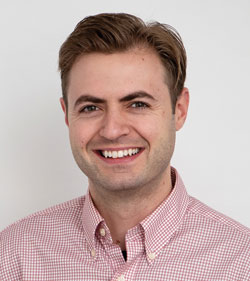On this episode of Conservation Ag Update, brought to you by Sound Agriculture, we head inside the first-ever Conversations about Conservation workshop for landowners at No-Till Innovator Mike Starkey’s farm in Brownsburg, Ind.
Plus, we have boots on the ground at the World Ag Expo and National Farm Machinery Show. Associate editor Mackane Vogel checks in from Tulare, Calif., with an up-close look at Pyka’s Pelican 2 — the largest autonomous crop protection aircraft on the market. Meanwhile in Louisville, Ky., Beck’s agronomist Steve Gauck shares lessons learned from new studies on corn root architecture.
In the Cover Crop Connection, New Jersey no-tillers Robert and R.J. Fulper try using a planter-mounted roller-crimper while planting green as part of a North Jersey RC&D on-farm trial.
And in the Video of the Week, Beaver Dam, Wis., strip-tiller Ryan Nell plants his soybeans on January 31st!
The Conservation Ag Update Podcast is brought to you by Sound Agriculture.
Sound Agriculture delivers bioinspired solutions that enrich soil and improve crops. Our synergistic products empower growers to achieve success while minimizing environmental impact.
SOURCE® activates the soil microbiome, unlocking nutrients for crops through advanced chemistry. BLUEPRINT™ offers the highest-quality arbuscular mycorrhizal fungi (AMF), extending root systems to improve nutrient and water access.
Beyond our products, Sound leads the way with programs that support growers in adopting sustainable practices to reduce reliance on synthetic fertilizers while maintaining productivity and profitability.
Full Transcript
Mackane Vogel:
Hey everyone, Mackane Vogel here in Tulare, California at the World Ag Expo. Welcome to Conservation Ag Update.
Noah Newman:
Conservation Ag Update is brought to you by Sound Agriculture. Thanks for that intro, Mackane. We'll check back in later as it was a big week for shows. We also have coverage from the National Farm Machinery Show coming up. But first we begin in the Indianapolis area where no-till innovator hosted a special event of his own. So let's head inside the first ever Conversations about Conservation workshop for Landowners at Starkey Farms in Brownsburg, Indiana. So the first of its kind educational and networking event was designed to convey to landowners the benefits of no-till and cover crops, and how they extend well beyond the rent check. Bob Barr of Indiana University, Indianapolis helped Starkey put this whole thing together with some support from the Nature Conservancy and other local organizations. So one of the big takeaways here is, fellow no-tillers would benefit greatly from hosting an event like this, to teach landowners what conservation practices will do for the land they're renting out.
Mike Starkey:
You got to get the thinking of, okay, what do landowners want to hear? And so instead of talking about how to improve their equipment for no-till or what kind of cover crop seed to purchase, so on and so forth, that type of agenda, they want to hear an agenda about their farm, their soil, their water, and hopefully transition their tenants in providing the soil health practice that I do. Contact your county and get a landowner list. I actually personally contacted all my landlords and a lot of neighboring landowners in our county, through our soil and water conservation district. Because we know who owns the land. It's public information. So we just actually just went directly to the landowners and sent the email out and sent him the agenda with the invite.
Mike Dunn:
Why this is important today is, here in Indiana, the watershed where we're at is about 50% of the farm ground is farmed by somebody that doesn't actually own it. And so today we're separating a conversation between landowners and farmers about conservation outcomes. What's something we can all better do together collectively?
Bob Barr:
The USDA and the NRCS, that's the Natural Resource Conservation Service, understand and see that a lot of the rental ground is just not being managed with conservation practices, and that population doesn't seem to really get a lot of the outreach. So one of the things we wanted to try to do is USDA said, how do we reach them? The farmers, the producers talk to each other, they go to the county extension agents, they go to the soil conservationists in the county. Absentee landowners or rented landowners often don't do that. So we wanted a way to reach those people. We came up with the idea of trying to put together an event like we often do to talk to each other, but to reach out to people outside of that core community.
Noah Newman:
And our Mike Lester will have more coverage from this event coming soon on NoTillFarmer.com. Moving on, another National Farm Machinery Show is in the books. And boy oh boy, as always, it was quite the spectacle with over 300,000 people packing the Kentucky Expo Center in Louisville. Our team got an up close look at some of the newest equipment, technology and innovations on the market. There were some great educational sessions as well. I learned a lot about Tar Spot from Beck's Agronomist, Travis Coleman. He says, "There's no silver bullet, but micronutrients, sulfur and early morning fungicide applications like before eight AM, can help mitigate risk." And you never know what you're going to see at this show, like this coyote transformer looking thing. Or how about this root cage at the Beck's booth. Steve Gawk, what can we learn from this?
Steve Gawk:
Now as we think about roots and we think about every time we up population, we're losing about 1% of roots a year out of corn. So we said, okay, well roots are higher, nutrients are uptaken, so is there different ways we should apply nutrients? So what we're learning here is a horizontal root system takes that nutrients and water, use our wetter clays, out of that top zone. Balance roots kind of go everywhere. Vertical root systems lean slightly towards more of a banded type fertilizer, more reaction. We're also noticing some stress tolerance differences. Vertical roots can go deeper for water, handle a little better stress tolerance.
Now ultimately, there's not a perfect root system and there's not necessarily that perfect root system for your farm. It's going to vary based on your fields and your soil types. So as we learn more about root architecture and we think about populations, what we notice is horizontal roots like a lower population. So they're more of your kind of flexier type hybrids. They need those roots to spread out. They don't like that competition. Where a balanced route goes about everywhere, in any population and a vertical root system will actually perform better in higher populations. So there's less competition as roots go down and pull nutrients out of the ground.
Noah Newman:
Yeah, very interesting stuff there. And we also have boots on the ground in Tulare, California. Mackane, what's going on at the World Ag Expo?
Mackane Vogel:
Thanks, Noah. Well, this week we're going to highlight one of the coolest products that I found at the World Ag Expo in Tulare, California. We're going to toss it over to the booth at Pyka where they're going to be showing off their new product, the Pelican II. It is herbicide and fungicide sprayer plane. Take a look at some of the specs.
Will Bergman:
What you're looking at here is an entirely autonomous, fully electric crop duster essentially, an aerial applicator. So it runs on four 25 kilowatt electric motors, and those are powered by three battery packs, which live in the nose over here.
So if you look over here, these are mockups right now, they're just sandbags inside of them, but this is about the size of our battery packs. And so three of them would fit in the nose there, and that supplies power. So the payload capacity of the drone is about 80 gallons, and you can see that on our tank on the side here. These are the fill lines, so you hold about 80 gallons. So the aircraft, like I said, it runs on a battery set with three batteries in it. And in order for you to stay continuously operating with the aircraft, we provide the system with four different battery sets. So each battery set takes about an hour to charge, and you generally get about 35 to 45 minutes of flight time out of each set. So by the time you've discharged the one on the plane, you've got a full set ready to go here. And they're hot swappable so you can just pull these out and slap one in the plane.
The idea is that it takes about the same amount of time to fill your plane to 80 gallons as it does to swap out a battery. But basically all your mission planning happens here on this laptop, and you can see a representative area here. So if you zoom in, let's say this is what you want to spray, you just draw in the polygon however you want. So you kind of just draw these vertices. Let's say you want to spray this area roughly, and you just upload this mission and then it will plan a path for you. So this is the path that the plane will now fly, and then we have this 3D visualizer over here on the right, that's sort of simulating what the plane would be doing in real life.
Mackane Vogel:
That's just one of several awesome products that we saw at the World Ag Expo this week. So stay tuned for future content in future episodes. And until next time, I'm Mackane Vogel. Back to you, Noah.
Noah Newman:
All right, good stuff there, thanks Mackane. Time now for the Cover Crop Connection, and today we're highlighting another on-farm trial from North Jersey RC&D. Long time no-tillers Robert and R.J. Fulper used a planter-mounted roller crimper to terminate their covers while planting green. Let's see how it went.
Robert Fulper:
The cover crops, when you plant through them, they lay down, they form a blanket that protects the soil, protects evaporation and things through the season. This year with the dry weather that our crops did better than we ever would've expected they would've done.
RJ Fulper:
I had a little damage crimping the beans, but it actually turned out in the end, the yields were fairly even again. With the drought, maybe it's because there was that extra thatch that kept the soybeans growing a little longer.
If the yield is even every year and it was all the same, I would still pick the cover crop and planting green because you're going to get the long-term benefits out of it.
Noah Newman:
Yeah, building long-term soil health is what it's all about for the Fulpers as they've been no-tilling since the 1970s. All right, video of the week now. Beaver Dam, Wisconsin, strip tiller, Ryan Nell plants his soybeans super early. He's always pushing the envelope. But this year he took it to a whole other level, planting some of his beans on January 31st. Ryan, what in the world? Tell us about this.
Ryan Nell:
3.5 acres of beans in the ground. We have been no moisture in the month of January. A little warmer here in the last week or so, we hit 50 degrees yesterday. We have frost about two to three inches guys. Fall stripped. We had to try it. I'm always up for a challenge, always up for a good time. We've been doing March beans since 2018, have not had a failure. Last year, March 3rd, planted 11 acres, I think they did over 80 bushel. Got to try it. Whether this is right or wrong, I don't know. This is asking a lot of the beans. Three months, I think we're asking the beans to sit in the ground for three months. I like the conditions. I like where they're planted. The pioneer treated bean, 140,000, about two, two and a quarter depth. See what happens. This is unknown territory. I hope it works out. We're going to keep an eye on these. Realistically, I hope I don't see anything until the end of April.
Noah Newman:
If you don't try, you won't know. That's Ryan's motto. See something unique in your neck of the woods, shoot me an email NNewman@LesterMedia.com. Thanks so much for tuning in to Conservation Ag update. I'm Noah Newman. Have a great day.













